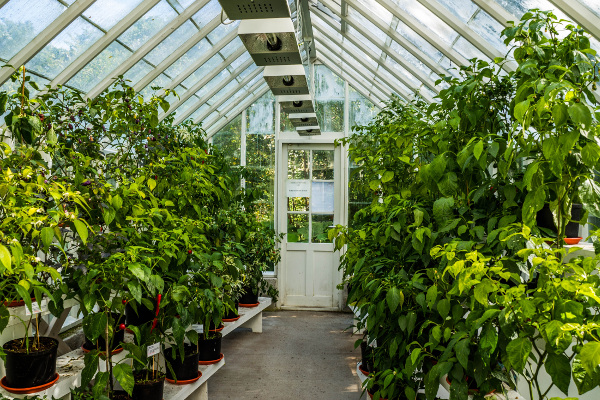Growing vegetables and herbs in a greenhouse will allow a significantly extended growing season for most people growing in colder climates. In addition to growing vegetables out of season, you could even grow vegetables from warmer zones in your backyard. You can also harvest a great deal of vegetables from a 10′ by 12′ greenhouse. With careful planning it is possible to feed a family of 4, assuming each family member eats a generous portion of vegetables daily.
Greenhouse gardening is not necessarily a luxury, as we develop and populate more and more of the land, we will need to move our gardening indoors in order to sustain our agricultural production. Greenhouse growers can produce a significant amount of crops from a small space, and can do so all year round. Gardening in a greenhouse also enables the gardener to grow crops that would not typically be grown in the area or to grow summer crops all year long for example. Imagine growing your own bananas in a cold zone 4 climate, for instance. A greenhouse could be attached to your home, or freestanding, it could have its own heat, plumbing, and electrical, or it could simply be some plastic wrapped around some sort of frame, much like many nurseries use to start their plants a little earlier than mother nature intended. In any event, you are sure to increase your harvest with a greenhouse. Here are a few things to consider when thinking about a greenhouse.
Temperature
Temperature (of the soil) is a major factor in determining plant growth. It controls the mechanism that allows minerals and nutrients to be absorbed from the soil. Greenhouses are heated passively by the infrared radiation that comes naturally off the sun, and typically insulated to minimize heat loss from convection (the greenhouse is sealed up, to keep drafts down). This passive heating is often enough to provide sufficient heat for growing in the winter months, even in the colder zones 5/4/3 for growing those vegetables that can tolerate some cold. In these climates, heat-loving vegetables will likely require some sort of supplemental heat. A greenhouse will also typically have some vents or windows to allow air to ventilate once the ideal temperature is exceeded. There are automatic controls for this, but two vents with a fan if necessary will likely get the job done with much less complexity and cost. Supplemental heat in the winter can be achieved with a standard electric heater, but remember it is more efficient to heat only the soil by using some sort of heat mat made for that purpose. Greenhouses aren’t nearly as well insulated as even an old house, so the energy required to heat a greenhouse could be significant.
Winter Growing
Several varieties of vegetables can be harvested in the winter months in a greenhouse with little supplemental heat. Most varieties of lettuce, spinach, chard, kale, broccoli, cabbage, Brussels sprouts, carrots, turnips, beets, and other cold-tolerant plants will continue to grow right through winter in a closed greenhouse. The clear greenhouse walls will allow the sun to warm the temperature well above freezing during the day, and it will drop to something close to freezing during the night; for this reason, it may be better to leave the heat-loving plants (tomatoes, peppers, squash, etc) for all but the coldest few months of winter. The natural daylight hours are the shortest in winter, so expect your vegetables to take slightly longer to fully mature. Plan on starting them a few weeks early to harvest during the winter.
Location and Orientation
Consider the greenhouse’s proximity to your main living area. If you have to wade through or shovel 1/2 mile of waist-high snow to get to your greenhouse in the middle of winter, you might reconsider the idea altogether. Placing the greenhouse as close as possible to your main living area will probably help to maximize its efficiency. This will also make it easier to supply water/electricity if that will be needed for your greenhouse. Other locations to avoid are those that might increase the likelihood of damage to the greenhouse panels/film. Maybe that spot next to the kid’s practice baseball field, or under that giant sycamore tree that is constantly dropping branches is not the best location.
The greenhouse should be orientated in a way that will maximize the sunlight. There are two basic schools of thought on greenhouse orientation. A greenhouse orientated to capture the morning sun (North/South orientation) will help to stimulate growth, remove condensation from leaves early in the day, and get your plants off to a good start for the day. This method is popular with those who use a greenhouse for summer vegetables. The other basic orientation is to maximize the winter sunlight captured (East/West orientation). The winter sun is much lower in the horizon this time of year, and with careful consideration of both structure and plants, it is possible to harvest vegetables without using a heat source to warm the greenhouse.
All decisions require compromises; if your greenhouse is attached to your house, or otherwise in the shadow of a tree or shrub, you may want to consider adding some supplemental lighting. It can be useful in two basic ways, for one it can offer some high-intensity light if unavailable. It can also increase the natural daylight to improve your growth rates. Many of the traditional light sources put off a significant amount of heat, and may also work as a heat source depending on the ratio of the size of your greenhouse and the number of lights you use.
